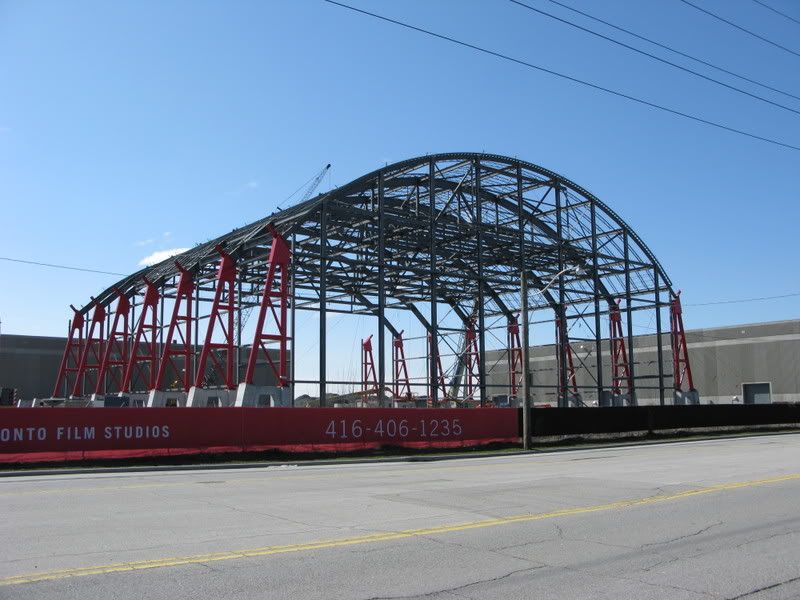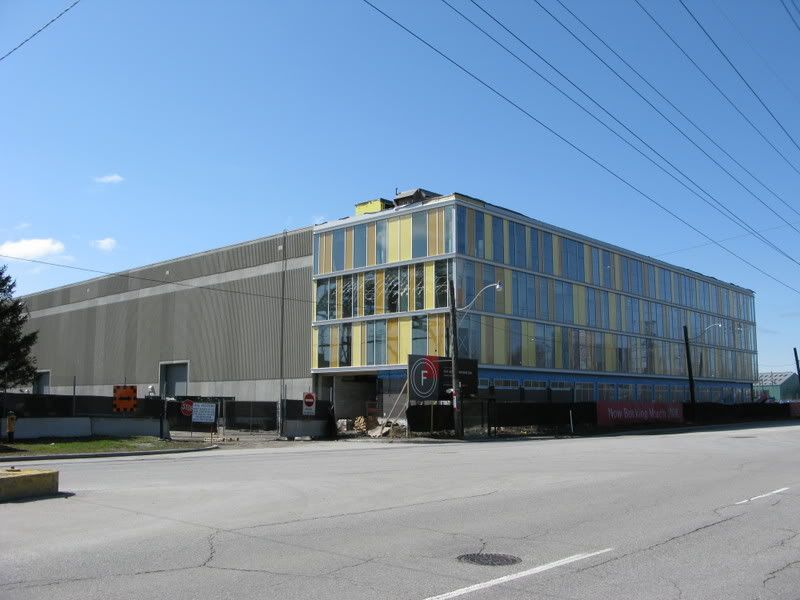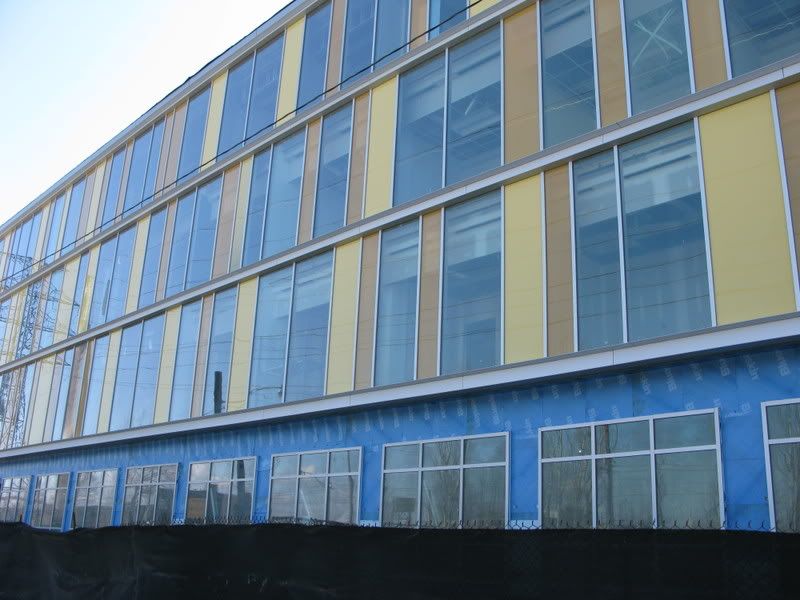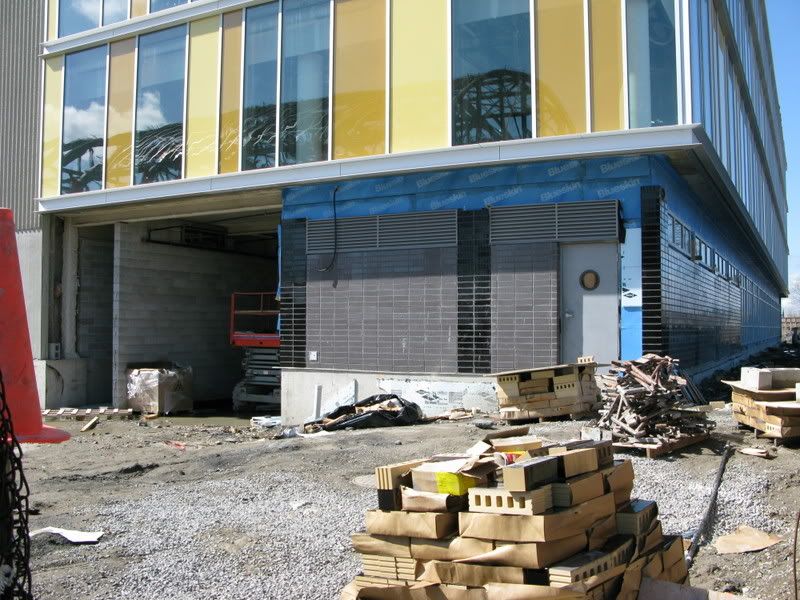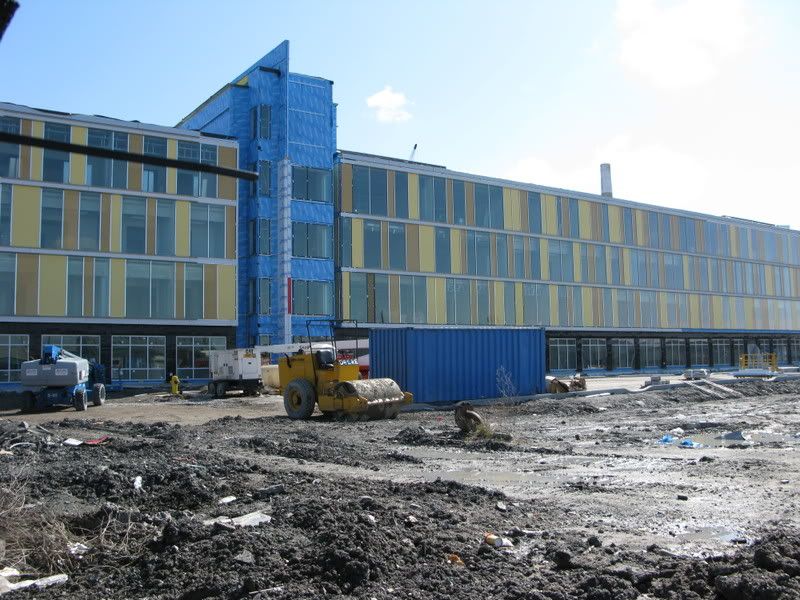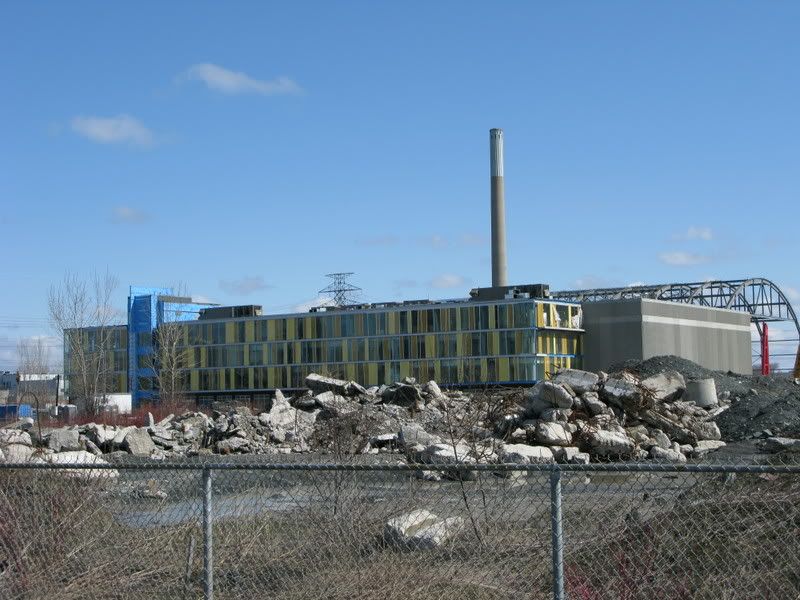From the Globe:
FILMPORT A NEW HOPE
WELCOME TO T.O.LLYWOOD
It may still look like a wintry wasteland, but Toronto's one-stop-shopping movie factory is set to be operational next month. Despite productions leaving the city and the dollar at par, the badly timed $700-million project may still see a happy ending. Jason McBride reports
JASON MCBRIDE
Special to The Globe and Mail
February 23, 2008
Hung from the fences surrounding Filmport, Toronto's film megastudio that has been a decade in the making, are signs emblazoned with an optimistic tagline: "Now in Production." On this wintry day in early February, however, the massive industrial site in the eastern Port Lands looks less like a dream factory than the silent surface of the moon. Snow-covered backhoes and booms sit as idle as playground equipment. A trio of workers roams the grounds, muttering into cellphones. Only a couple of forbidding grey bunkers, each the size of a couple of football fields - sound studios, as it turns out - appear finished. A glass-fronted, four-storey production office is halfway there, its insulation and steel beams still exposed. A dozen other concrete buttresses poke out of the snow. The entire spectacle would inspire only the most imaginative budding Bergman.
But imagination - not to mention great reserves of patience and very deep pockets - is precisely what has brought Filmport to this point. Toronto's film and television industry has long dreamed of such a project - a state-of-the-art studio complex where production companies from all over the world can come to rent out space, surrounded by restaurants, a skating rink, movie screens and other public attractions that make it a self-contained mini-city not unlike Universal Studios. Indeed, Filmport may be the one-stop shop that will finally make the dubious appellation Hollywood North feel entirely earned.
Filmport's timing, of course, has not been exactly fortuitous. At its height in 2000, the film industry spent $1.3-billion filming in Toronto; in 2006, according to the Toronto Film and Television Office, that number dropped to a heart-stopping $700-million. Just as Filmport construction began last fall, the city issued the clumsily titled document Bounce Back to Fast Forward, a strategic plan "to correct the current disastrous state of the industry." That same month, the dollar hit parity. And, in November, the Writers Guild of America went on strike, jeopardizing yet another summer of shooting. While that strike ended just in time for the Oscars, the possibility of a June strike by the Screen Actors Guild still looms.
But in such an unfriendly climate, Filmport and Toronto Film Studios president Ken Ferguson maintains that the city still has an edge in an extremely competitive industry, one that only needs a home like Filmport to be capitalized on. "What we have in Toronto," he says, "is our really deep bench strength. The unions here are second to none. We have one of the largest acting pools outside of L.A. We have Deluxe and Technicolor, two major post-production houses here, who are able to do world-class stuff. It'll take any other place 20 years to build up the expertise that we have in Toronto, expertise that we're not utilizing."
lights, camera ... action?
A megastudio for Toronto has been a long time coming. Over the past decade and more, similar projects (Cinevillage, the Image Factory, a Mike Harris-led deal with U.S. film company Studios of America) have been squandered or abandoned. Filmport, a union of Toronto Film Studios, its parent company, the Rose Corporation, and Paul Bronfman's Comweb Group - owner of William F. White International, one of the world's largest film-equipment suppliers - finally broke ground last September on brownfield lands leased from the Toronto Economic Development Corporation (TEDCO) east of the Don River and south of Lake Shore Boulevard. The first phase of the development - comprising seven sound stages - is scheduled to be operational by the end of next month.
But given the current challenges, Mr. Ferguson isn't quite ready to celebrate. Slim and soft-spoken, the former engineer and real-estate developer has a slightly embattled air - no surprise, given the vexing decade he has spent lobbying, agitating and planning for this moment. In 1998, Toronto Film Studios turned moribund warehouse space on Eastern Avenue into what became temporarily the country's largest film studio. The company acquired the adjacent Alliance Atlantis Cinevillage building in 2003; current tenants include CBC's The Border and Rhombus Media's adaptation of José Saramago's Blindness. Now, Toronto Film Studios will become the anchor tenant in what Mr. Ferguson calls "the Filmport community."
"We're excited, but a little apprehensive," he says in the company's tasteful boardroom on Eastern Avenue, surrounded by dozens of architectural renderings and maps. While Filmport will open its doors this spring, Mr. Ferguson is unwilling to name any specific shows that have booked space. (A paltry half-dozen foreign productions are currently shooting in the city.) "The strike made things a little quiet around Hollywood," he says. "Everyone's just hedging their bets now."
Peter Finestone, the city's acting film commissioner, whose office produced the strategic plan, is somewhat more sanguine. "I'm always optimistic," he says of the current climate. "It's been hard for lots of people. But we're well positioned. If we continue to do what we do well - make great movies - things will eventually shake out."
Once Filmport's utopian renderings become a reality - construction should be complete by 2018 - the complex will boast some staggering stats: Occupying a 50-acre site in total, the Studio Lot, as it's called, will comprise 550,000 square feet of production facilities, including more than a dozen sound stages, office space, wardrobe houses, prop shops, a commissary and numerous other amenities. The Studio Lot will be complemented by a Commercial Campus featuring everything else a movie or TV show production might require, from editing bays to daycare - and, eventually, a whole range of other attractions: restaurants and bars, a boutique hotel, even a Canadian Cinematic Hall of Fame.
Late last summer, Filmport excitedly announced that Will Alsop, the architectural brains behind the Ontario College of Art & Design's Sharp Centre, would be designing a new building for the complex's main gate - the mothership, perhaps - a multi-use, 11-storey edifice scheduled to open in 2010, its flowing red glass-curtain wall inspired by the tankers that once sailed through these channels. And then, this January, Deluxe, the city's foremost post-production facility, announced that it would move its headquarters into Filmport, also in 2010.
According to Mr. Ferguson, the project will create a total of three million square feet of building space, the largest such enterprise in North America outside L.A. And the fact that large portions of Filmport will be open to the public makes it a complete package that places like Rome's famed Cinecitta Studios or many other Hollywood lots can't duplicate. "It'll really be a Dundas Square-type environment," Mr. Ferguson says. On the company's maps, the current Don Roadway has been renamed Filmport Boulevard.
combating pessimism
and controversy
The city has weathered production-crippling storms before - 9/11, SARS, West Nile - but Mr. Ferguson stresses that the film industry now needs to significantly change the way it does business. Without the incentive of a low dollar or cheap, plentiful warehouse space (consumed by condo development) and with competition from all over North America - everywhere from Vancouver to Louisiana now offer comparable tax incentives and solicitous film offices - Toronto needs to emphasize the extensive infrastructure the city has built over the past 40 years, the professionalism of our film crews and facilities.
The present situation has been made worse by a dearth of high-quality, purpose-built studio space in the city. Rather than saying, well, the productions aren't shooting here so there's no point in building new space, Mr. Ferguson espouses a "build it and they will come" mentality. Last year, The Incredible Hulk ate up most of Toronto Film Studios; other big Hollywood films such as G.I. Joe passed on the city partly because of inadequate sound stages (in G.I. Joe's case, heading to L.A. and Prague).
As seemingly welcome as Filmport is, the development has not been without controversy. Last fall, the Rose Corporation sold much of the Toronto Film Studios land at 629 Eastern Ave. to SmartCentres, a retail developer well known for its suburban power centres, and the studio is currently leasing the land and buildings back until the property is redeveloped.
A proposal last May to build an enormous shopping plaza, with 650,000 square feet of retail and, possibly, a Wal-Mart, incensed citizen groups and councillors in Leslieville and Riverdale. Such a proposal contravenes a ban on big-box development in the area - and many residents' wishes to preserve both the residential neighbourhood's character and the Studio District's industrial opportunities.
At a public meeting last summer, SmartCentre vice-president of development Tom Smith met with an angry group of residents at Ralph Thornton Hall. To Mr. Smith's claim that the design of the shopping centre was "totally geared to the pedestrian," one resident shot back, "Then why does it have 2,000 parking spaces?"
While revenue from that sale has certainly helped bankroll Filmport's construction, the SmartCentres squabble is somewhat tangential to the complex's genesis. A more significant conflict might be with Cinespace, a rival studio within clear view of the Filmport site. Cinespace had one of its primary studios on Queens Quay East - which it had leased from TEDCO - abruptly shut down a year ago to make way for the construction of Corus Entertainment's new headquarters. That eviction meant the loss of 140,000 square feet of space, long before Filmport could make up for the shortfall.
Cinespace's principals, Jim and Steve Mirkopolous, have been vocal critics of TEDCO, calling it a rogue agency and joining an appeal to make public the terms of Filmport's so-called sweetheart deal with TEDCO. TEDCO - an arm's length corporation of the city responsible for the sustainable development of underutilized lands - gave Filmport a 99-year lease for an undisclosed figure, with an additional non-compete clause preventing TEDCO from leasing adjacent land to other studio operators. (Cinespace did not return calls for comment.) Mr. Ferguson has been critical of TEDCO's machinations himself: "It took a long time," he says, "and we almost walked away many times. It's the cultural difference between the private and public sectors. But more such partnerships should be done, notwithstanding that they're very difficult."
While he won't divulge the terms of the deal, he is quick to point out that the project has not received a single taxpayer dollar. "The city's broke," Mr. Ferguson says, and neither the Harris nor the McGuinty government saw fit to pony up money for the project. The total budget for Filmport is estimated at $700-million, and the price tag for Phase 1 is $60-million - the shareholders are investing half of that in equity capital.
"That's quite a high ratio of equity," Mr. Ferguson says. "The bank loan that we've got is only for 50 per cent of the construction. It meant that our group is having to put a lot more at risk, and it means your return on investment is slower. Obviously, our hope is that there will be enough commercial development that will offset the risk that it takes to go ahead with the first phase."
To that end, Filmport is negotiating with a dozen other possible tenants, and, while Mr. Ferguson again refuses to name names, he alludes to the guilds and unions, other production suppliers, and even, at some point, media companies such as Bell or Rogers. And if Hollywood fails to return to Toronto, portions of the Studio Lot could be repurposed for other commercial development - hence the street-grid-like design of the lot.
Filmport's also minimized its risk by lobbying various governments to make filming in Toronto more attractive. Along with other financial leaders, Mr. Ferguson helped push forward the mayor's proposal to grant expanding Toronto businesses a 10-year property-tax break. And the province recently boosted industry tax credits for foreign productions to 25 from 18 per cent on eligible labour expenditures. While it's too early to tell whether this will be enough incentive to offset a still-strong dollar (not to mention the fact that Manitoba and Saskatchewan still offer considerably higher credits), Queen's Park boasted that the increase would pump an additional $50-million into local production.
Ultimately, Mr. Ferguson and his fellow shareholders are putting their money where their mouths are, their continuing faith in Toronto as a filmmaking capital embodied in the very fact that Filmport, for all of its uncertainties, is being built at all.
"It's one of those overnight successes," he says, with the smallest of smiles, "that happened over a much longer period of time. I think it's an amazing vision, one that we dreamed for a while. It's kind of a volatile industry, but day by day, our vision is being endorsed by more and more people. It's actually happening."
The good, the bad, and the ugly: a Toronto film industry timeline
1904
The first film is shot in Toronto, George Scott's The Great Toronto Fire.
1959
Nat Taylor opens the Toronto
International Film Studios in Kleinburg, Ont., featuring two
of the largest sound stages outside Hollywood.
1978
Daryl Duke directs The Silent Partner (produced by Garth Drabinsky, screenplay by Curtis Hanson) - the beginning of the tax-shelter boom years (which ended in 1996).
1981
Porky's is released, becoming Canada's biggest box-office success worldwide.
1997
Ontario introduces its own tax credit system, encouraging
producers to use local labour.
January, 1998
The Rose Corp. acquires the foundering, bankrupt Toronto Film Studios.
2000
Producers spend $1.3-billion in
Toronto on major productions
(including animation).
April, 2006
Karen Thorne-Smith is appointed the city's first film commissioner, responsible for developing relationships between film and TV producers, the City of Toronto and other relevant governments. She stepped down last summer to become the president and chief executive officer of the
Ontario Media Development Corp. Peter Finestone is the current acting film commissioner.
2000 - 2006
Toronto stands in for 28 American states, two provinces, Britain, France, Germany, Russia and
Israel.
September, 2007
Out of continuing fears of runaway productions, the American Film and Television Action Committee files a petition with the U.S. trade representative office to investigate Canada's "unfair" film subsidies.
Jason McBride
Sources: Take One, Toronto Film and Television Office, FilmOntario
AoD

